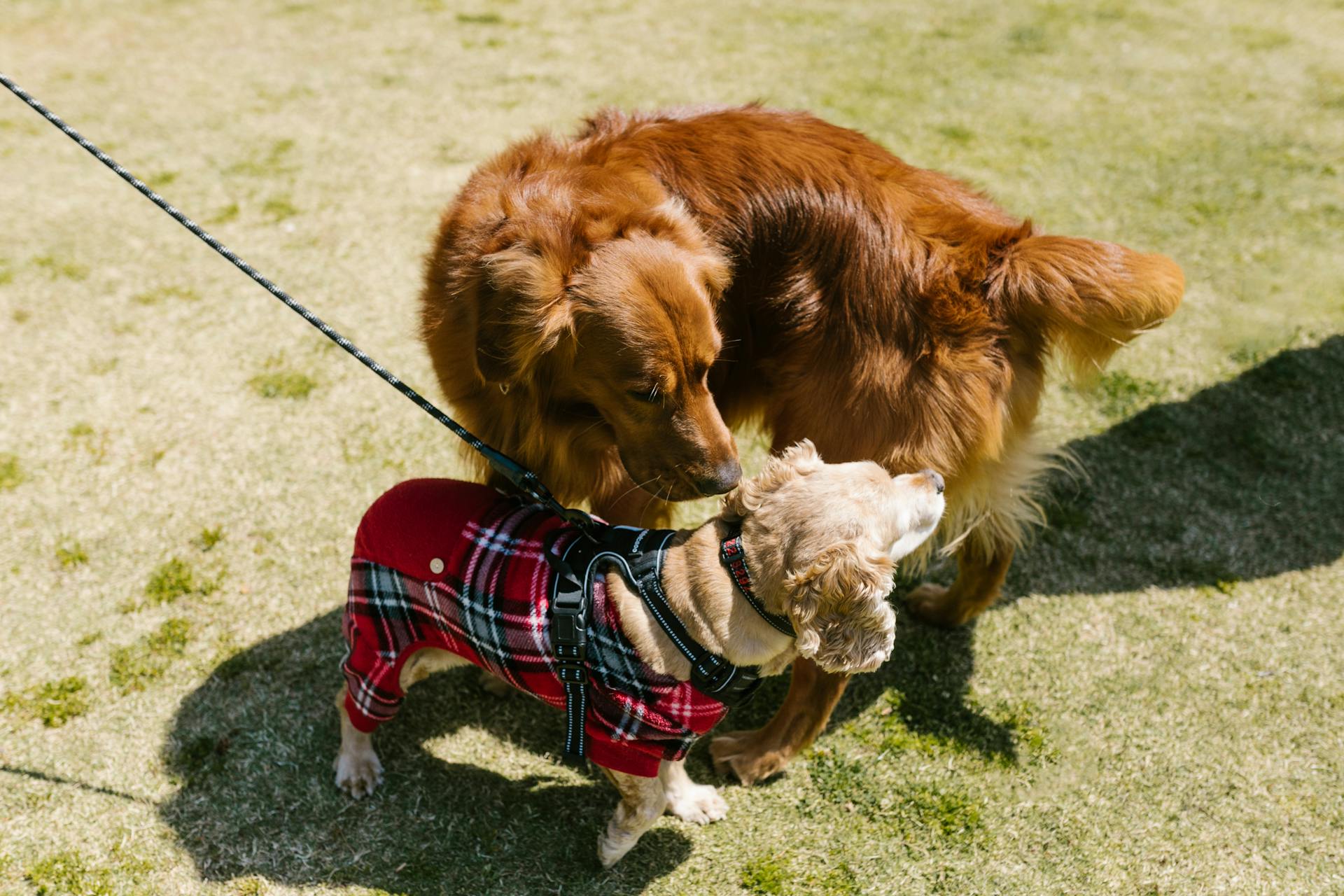
Giving dogs pills without food can be a challenge, but it's not impossible.
You can use a pill pocket or a treat to disguise the pill, but this method may not work for every dog.
Some dogs are more willing to take pills if they're given in a quiet and calm environment.
The ideal time to give your dog a pill is when they're most relaxed, such as after a walk or a playtime.
Curious to learn more? Check out: Can I Crush My Dogs Pills in Water
Giving Pills to Dogs
Giving pills to dogs can be a challenging task, but with the right tools and techniques, it can be made easier. A pill pusher or pill gun is a great tool to use for smaller dogs, as it allows you to place the pill at the back of the dog's mouth with greater precision.
If your dog is having trouble swallowing pills, try asking for a flavored version or a liquid form of the medication. Some pills can be crushed into a fine powder and coated in a gelatin pill capsule to mask the smell.
There are several styles of pilling devices available, including pill launchers and pill poppers, which can be used to place the pill at the back of the dog's mouth without having to put your fingers in their mouth.
If your dog is still having trouble swallowing pills, consider using a pill pocket, a commercially available treat that includes a hole sized just right for hiding medication. Some popular brands include Greenies Pill Pockets and Zoe Pill Pop.
Use a Gelatin Pill Capsule
If your dog won't eat a pill because of the smell, try encasing it in a gelatin pill capsule to mask the odor. This can make your dog more open to swallowing the pill.
Pill capsules are a great solution because they don't significantly increase the size of the pill, making it easier for your dog to swallow.
Encasing the pill in a gelatin capsule can make a big difference in getting your dog to take its medication.
See what others are reading: Dog Pill Treats
Slip into Treats
You can hide pills in commercially available treats called pill pockets, which come in different flavors and are nutritionally balanced.
These treats are designed to be easy to use and are available for both dogs and cats. Look for a brand that's lower in calories if your pet is overweight.
Some options to try include Greenies Pill Pockets Canine Real Peanut Butter Flavor Dog Treats and Greenies Feline Pill Pockets Salmon Cat Treats.
To avoid suspicious behavior, pair a medicated treat with one that's not medicated. Give your pet one or two plain treats, then a medicated one, then one or two more plain treats.
If you do this rapidly, your pet will swallow the treats quickly without examining them.
A different take: Chick Fil a Dog Treats
How to Give Your Dog a Pill
Giving your dog a pill can be a daunting task, but with the right techniques and tools, it can be a breeze. Use a pill pusher for smaller dogs, as it allows for greater precision and keeps your hand out of your dog's mouth.
You can also try using a gelatin pill capsule to mask the smell of the pill and make it easier for your dog to swallow. These capsules are great because they don't significantly increase the size of the pill, making it easy for your dog to swallow.
To give your dog a pill, hold their head from the top using your left hand if you're right-handed, and tilt their head back. This will help the lower jaw drop open and create a clear pathway for the pill to enter the back of their mouth.
You can also use a pilling device to place the pill over the base of your dog's tongue without having to put your fingers in their mouth. There are several styles of these devices available, so you can choose the one that works best for you and your dog.
If your dog is particularly stubborn, you can try the "JAWS" method, which involves grasping the upper and lower jaws and gently pulling them open. This will give you access to the back of your dog's tongue, where you can deposit the pill.
If your dog won't eat their medication with food, you can try opening their mouth and placing the pill on the back of their tongue. Tilt their head back to help the lower jaw drop open, and close their mouth to encourage them to swallow.
Here's an interesting read: Will Hawks Attack Small Dogs
Alternatively, you can use a pill-launcher or pill popper to launch the pill into the back of your dog's mouth. These gadgets can be especially helpful if your dog is resistant to taking medication.
If all else fails, you can try looking for a different version of the pill that comes in a flavored form or liquid. Some medications can also be crushed into a powder and coated onto your dog's tongue or mouth to encourage them to swallow.
Finally, you can try slipping the pill into a specially made treat called a pill pocket. These treats come in different flavors and are designed to be easy to use and nutritionally balanced. Always pair a medicated treat with a plain one to avoid raising your dog's suspicions.
Administering Medication
Administering medication to your furry friend can be a daunting task, but with the right techniques, you can make it a breeze. Liquids are more likely to enter the windpipe than pills or capsules, so be sure to hold the mouth closed and encourage swallowing with a gentle stroke on the neck or a sharp blow on the nose.
To avoid accidental inhalation, don't tilt the dog's head backward when giving liquids. This can be a tricky situation, but with practice, you'll get the hang of it.
If your dog is having trouble swallowing pills or capsules, try hiding them in a tasty treat like peanut butter, liverwurst, or cheese. Just be sure to clear the treat with your veterinarian first, as some medications can interact with certain foods.
Some popular food options for hiding pills include:
If your dog is still resistant to taking medication, try using a pill-launcher or a "pill popper" tool. These gadgets can make the process much easier and less stressful for both you and your dog.
To give a dog pills or capsules, hold the head from the top and tilt it back. Gently fold the upper lip over the teeth and place the pill or capsule as far back over the tongue as possible.
Tips and Strategies
If you're having trouble getting your dog to take a pill, try asking for a flavored version. Some medications come in liquid form or can be crushed into a powder, making them easier to administer.
You can also try the "JAWS" method to open your dog's mouth and deposit the pill at the back of their tongue. This involves grasping the upper and lower jaw just behind the canine teeth and pulling them open. Some dogs may require more coaxing than others, especially if they have strong jaws like pit bull mixes.
If your dog won't eat their medications with food, you can try the following two methods:
Tilting your dog's head back can help their lower jaw open, making it easier to deposit the pill at the back of their tongue. This can be a natural and easy way to get the pill down.
Use a Pill Box
Using a pill box is a great way to store your dog's medication in one place. You can keep it in a convenient location, like the bathroom or kitchen, so you don't forget to give your dog their medication.
A pill box can help you organize your dog's medication schedule, making it easier to remember when to give each dose. This can be especially helpful if your dog takes multiple medications at different times of the day.
You can use a pill box with compartments to separate your dog's medication into different days of the week. This can help you stay on track and avoid giving your dog too much or too little medication.
Related reading: Dog Diaper Training
Top 5 Tips
Try a flavored version of the pill if your dog is finicky. Some medications come in various forms, including liquid or powder.
Hold the dog's head from the top using your left hand if you're right-handed. This is especially important if the dog has a long nose.
Tilt the dog's head back to open its mouth. Dogs have strong jaw muscles, making it hard to get the pill far back over the tongue.
Gently fold the upper lip over the teeth as you open the mouth. This reduces the chance of getting bitten.
Drop the pill or capsule as far back over the tongue as possible, then immediately close the mouth and blow on the dog's nose to encourage it to swallow.
The Bribe for Food-Motivated Dogs
Using high-value treats is a great way to motivate food-driven dogs. High-value treats are small, tasty, and highly rewarding.
For example, a study on clicker training found that dogs are more likely to perform a behavior when a high-value treat is offered.
Dogs with food motivation can learn quickly with the right rewards. A reward schedule that offers treats at the exact moment of a desired behavior can be very effective.
Treats like freeze-dried liver or chicken strips are great options for high-value rewards. These treats are small, easy to eat, and highly prized by dogs.
Using a consistent reward schedule can help your dog learn quickly and avoid overeating.
Explore further: Is High Protein Dog Food Good for Dogs
3 Ways to Give a Pill
Giving a pill to your dog can be a challenging task, but with the right tools and techniques, it can be done safely and effectively. A pill pusher is a great tool to use for smaller dogs, allowing you to get the pill to the back of their mouth with greater precision.

You can also try using a gelatin pill capsule, which can help mask the smell of the pill and make it easier for your dog to swallow. This is a great option if your dog is sensitive to smells.
If you're feeling confident, you can try the "JAWS" method, which involves grasping the upper and lower jaw just behind the canine teeth and gently pulling the jaws open. This can be a bit tricky, but it's a great way to get the pill into the back of your dog's mouth.
Here are some general tips to keep in mind when giving a pill to your dog:
To give a pill to your dog, hold their head from the top using your left hand if you're right-handed. Tilt their head back and gently fold their upper lip over their teeth as you open their mouth. Place the pill or capsule as far back over the tongue as possible and close their mouth, then blow on their nose to encourage swallowing.

If your dog won't eat their medication with food, you can try opening their mouth and placing the medication on the back of their tongue, then closing their mouth and waiting until they swallow. Alternatively, you can use a pill-launcher tool, such as a pill popper, to help administer the pill.
Frequently Asked Questions
Is it okay to crush pills for dogs?
Crushing pills for dogs is not recommended without consulting a veterinary team, as it can cause unwanted side effects or reduce the medication's effectiveness. Always follow your vet's advice when administering medication to your dog.
Sources
- https://www.hepper.com/how-to-give-dogs-pills-without-food/
- https://hospital.vetmed.wsu.edu/2022/01/12/giving-oral-medications-to-your-dog/
- https://toegrips.com/dog-wont-take-pills/
- https://www.dailypaws.com/dogs-puppies/health-care/how-to-give-a-dog-a-pill
- https://topdoghealth.com/how-to-give-dog-medication/
Featured Images: pexels.com


